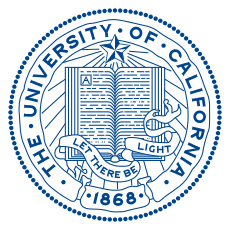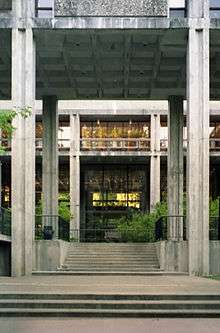Jack Baskin School of Engineering
 | |
| Established | 1997 |
|---|---|
| Dean | Alexander L. Wolf |
| Location | Santa Cruz, California, United States |
| Affiliations | University of California, Santa Cruz |
| Website | http://www.soe.ucsc.edu/ |
 | |
The Jack Baskin School of Engineering is the school of engineering at the University of California, Santa Cruz. The school trains students in seven departments: Applied Mathematics & Statistics, Biomolecular Engineering, Computational Media, Computer Engineering, Electrical Engineering, and Technology Management. The school of engineering was formed in 1997 and endowed through a multimillion-dollar gift from retired local engineer and developer Jack Baskin.[1]
Majors & Degrees Offered
| Majors & Degrees Offered | B.A. | B.S. | M.S. | Ph.D. | Other |
|---|---|---|---|---|---|
| Applied Mathematics and Statistics | * | * | |||
| Bioengineering | * | ||||
| Bioinformatics | * | ||||
| Bioinformatics & Biomolecular Engineering | * | * | B.S/M.S, B.S./Ph.D | ||
| Computer Engineering | * | * | * | B.S./M.S. | |
| Computer Science | * | * | * | * | |
| Computational Media: Computer Game Design | * | ||||
| Computational Media | * | ||||
| Electrical Engineering | * | * | * | ||
| Games & Playable Media | * | ||||
| Network and Digital Technology | * | ||||
| Robotics Engineering | * | ||||
| Scientific Computing & Applied Mathematics | * | ||||
| Technology and Information Management | * | * | * |
Baskin Engineering offers undergraduate degree programs in:
- Applied Mathematics & Statistics
- Bioinformatics
- Bioengineering
- Bioinformatics and Biomolecular Engineering
- Computer Engineering
- Computer Science
- Computational Media: Computer Game Design
- Electrical Engineering
- Network & Digital Technology
- Robotics Engineering
- Technology and Information Management
Baskin Engineering offers MS and PhD programs in these disciplines.
- Applied Mathematics & Statistics
- Bioinformatics & Biomolecular Engineering
- Computer Engineering
- Computer Science
- Computational Media
- Electrical Engineering
- Games & Playable Media
- Scientific Computing & Applied Mathematics
- Technology & Information Management
Research
Student Organizations
- Association for Computing Machinery (ACM)
- Bioengineering Club
- Biomedical Engineering Society (BMES)
- Engineers for Change (EFC)
- Engineering Graduate Student Association (EGSA)
- eWomen at UC Santa Cruz
- Institute of Electrical and Electronics Engineers (IEEE)
- Information Systems Management Association (ISMA)
- National Society of Black Engineers (NSBE)
- Queer Geeks
- Santa Cruz Linux User's Group (Slug LUG)
- Security Santa Cruz (SSC)
- Society for the Advancement of Chicanos and Native Americans in Science (SACNAS)
- Society of Asian Scientists and Engineers (SASE)
- Society of Hispanic Professional Engineers (SHPE)
- Society of Women Engineers (SWESLUGS)
- Tau Beta Pi (TBP)
- The Element Lounge (TEL)
- Women in Science and Engineering (WISE)
Centers and Institutes
Centers
- W.M. Keck Center for Adaptive Optical Microscopy
- Center for Biomolecular Science and Engineering (CBSE)
- Center for Games and Playable Media
- Center for Information Technology Research in the Interest of Society (CITRIS)
- W.M. Keck Center for Nanoscale Optofluidics
- Center for Research in Open Source Software (CROSS)
- Center for Research in Storage Systems (CRSS)
- Storage Systems Research Center (SSRC)
- UCSC Data, Discovery and Decisions in Data Science (D3)
Institutes
- California Institute for Quantitative Biosciences (QB3)
- Institute for the Biology of Stem Cells (IBSC)
- Information Technologies Institute (ITI)
- UC Santa Cruz Genomics Institute
Deans
- Founding Dean: Patrick E. Mantey, July 1997- December 2000
- Sung Mo "Steve" Kang, January 2001- February 2007
- Acting Dean: Michael S. Isaaccson, January 2006- June 2006, March 2007-April 2009
- Arthur P. Ramirez, May 2009-June 2014
- Interim Dean: Joseph P. Konopelski, July 2014-June 2016
- Alexander Wolf, 2016-present
Silicon Valley
Baskin Engineering conducts classes, career training, and professional development programs at the Silicon Valley Center, located in the NASA Ames Research Center at Moffett Field in Mountain View, California. Tracks include product management, technology and commerce, data mining, reliability engineering, advanced device engineering, and network engineering.
Facilities
The 212-seat Baskin Engineering Auditorium and Engineering 2 building, a 150,000-square-foot (14,000 m2) space, were completed for occupancy in the summer of 2004. The Physical Sciences Building provided additional space for biomolecular engineering programs and groundbreaking for a new Biomedical Sciences Building in 2010.
References
External links
- Jack Baskin School of Engineering
- Photographs of Jack Baskin School of Engineering from the UC Santa Cruz Library's Digital Collections
Coordinates: 37°00′04″N 122°03′47″W / 37.001°N 122.063°W
